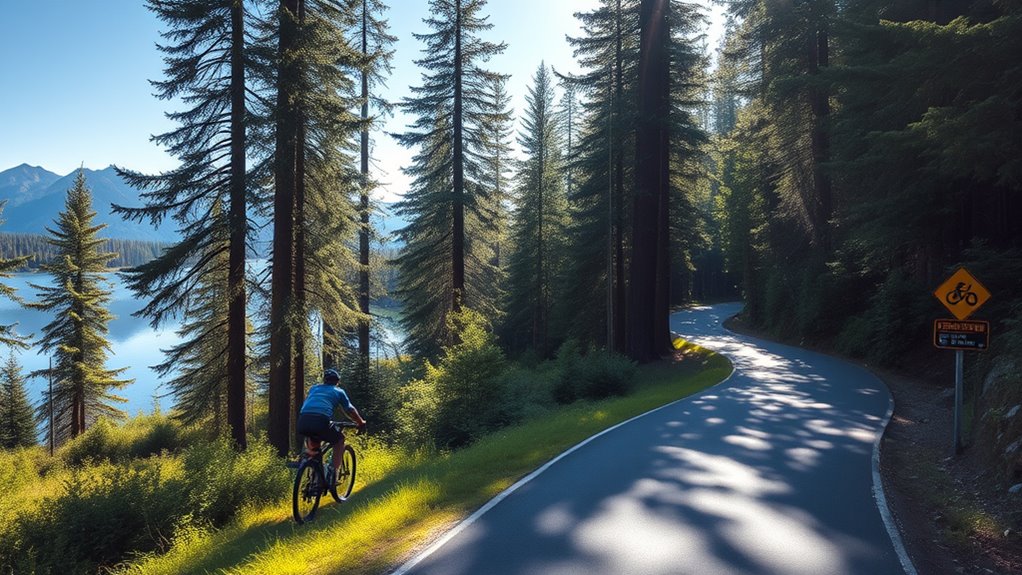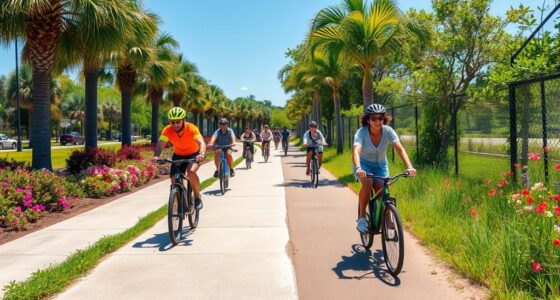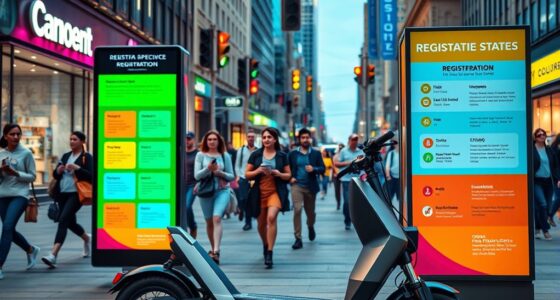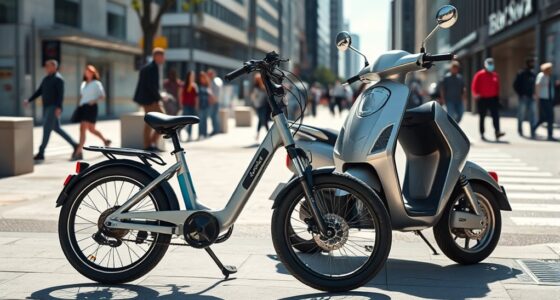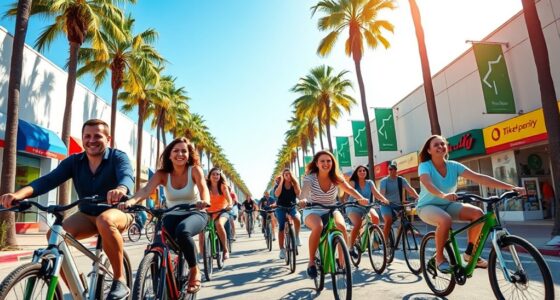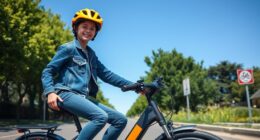In Washington State in 2025, your e-bike class determines where you can ride. Class 1 and 2 bikes are allowed on most bike paths and trails, but Class 3 bikes face restrictions in certain parks and pedestrian areas. Helmet use is required for all riders under 18 and needed at all times for Class 3 riders. Make sure to follow traffic laws, signals, and signage, and you’ll stay safe and compliant. If you continue exploring, you’ll find more tips to enjoy safe e-biking everywhere.
Key Takeaways
- Class 1 and 2 e-bikes are generally allowed on most bike paths and trails in Washington State.
- Class 3 e-bikes often face restrictions in parks and pedestrian-heavy areas; check local signage.
- Helmets are legally required for all riders under 18; adults are recommended but not always mandated.
- Riders must follow traffic laws, obey signs, and use designated lanes when riding e-bikes.
- Recognizing e-bike classes ensures legal access and safe riding on paths and parks in Washington.
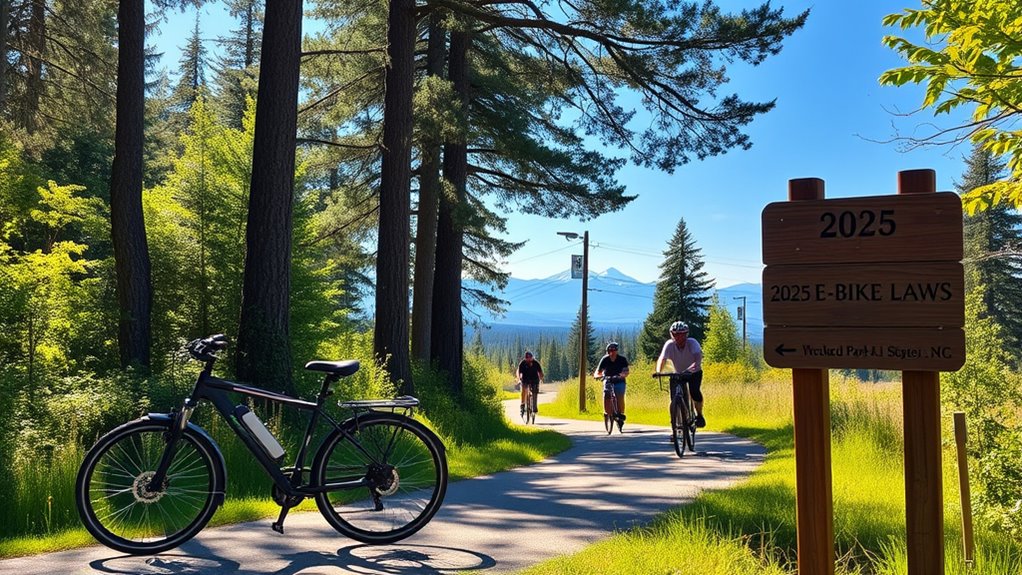
Are you wondering how e-bike laws in Washington State impact your rides? Understanding the motorized classification is essential because it determines where and how you can ride your e-bike. In Washington, e-bikes are classified into three categories based on their motor power and speed capabilities. Class 1 e-bikes provide pedal-assist only up to 20 mph, with motors that cut off once you reach that speed. Class 2 bikes also have a maximum speed of 20 mph but feature a throttle system that can be used without pedaling. Class 3 models assist up to 28 mph and usually require specific safety gear. Recognizing your e-bike’s classification helps you comply with state laws and ensures smooth access to trails, parks, and bike paths.
Understanding Washington’s e-bike classifications helps ensure legal, safe, and enjoyable riding experiences.
When it comes to helmet requirements, Washington State emphasizes safety, especially for riders of certain classifications. If you’re riding a Class 3 e-bike, you are legally required to wear a helmet at all times. This rule aims to protect riders from head injuries, particularly since Class 3 bikes can reach higher speeds. For Class 1 and 2 e-bikes, helmet use is strongly recommended but not legally mandated for adults—though local jurisdictions or specific trail rules might impose their own helmet requirements. If you’re under 18, helmet laws are stricter across the board, requiring all young riders to wear a helmet regardless of e-bike class.
The motorized classification also influences where you can ride. For example, Class 1 and 2 e-bikes are generally permitted on most bike paths, bike lanes, and designated trails, making them versatile options for commuting or recreational rides. Conversely, Class 3 bikes are often restricted from certain bike paths and parks, especially those with more pedestrian traffic or designated non-motorized areas. Always check local signage and regulations to avoid fines or riding restrictions.
In addition to classification and helmet rules, Washington’s laws specify that e-bike riders must follow the same traffic rules as traditional cyclists. This includes obeying traffic signals, riding in designated lanes, and signaling turns. Being aware of your e-bike’s classification and helmet requirements helps you stay compliant and safe, whether you’re cruising through city streets, exploring parks, or enjoying scenic trails. Proper headphone use can also enhance your riding experience by allowing you to stay alert and aware of your surroundings, especially when riding on busy roads or trails. By understanding these laws, you can confidently ride your e-bike while respecting Washington’s regulations, ensuring enjoyable and incident-free adventures on two wheels.
Frequently Asked Questions
Are E-Bikes Allowed on All Washington State Trails?
You can ride your e-bike on many Washington state trails, but not all. Check specific trail rules before heading out, especially for bike theft prevention and safety. Look for designated e-bike areas, and plan to use e-bike charging stations if needed. Staying informed helps you enjoy your ride without issues, and respecting trail restrictions guarantees access remains open for everyone. Always verify trail rules beforehand to avoid surprises.
Do E-Bike Laws Differ Between Urban and Rural Areas?
You’ll find that e-bike laws do differ between urban and rural areas. In cities, regulations often address urban congestion and focus on designated bike lanes and shared paths, while rural infrastructure may have fewer restrictions, emphasizing trail access and safety. Notably, around 60% of riders report using e-bikes to navigate urban congestion more efficiently. So, check local rules to enjoy your ride safely, whether in busy streets or quiet countryside.
Can Minors Legally Ride E-Bikes in Washington?
Yes, minors can ride e-bikes in Washington, but there are minor restrictions. The legal age to ride an e-bike is generally 16, and minors under that age need to be supervised or have specific permits. You should verify the minor follows local laws, including helmet use and where they can ride. Always check the latest regulations because laws may change, and different areas might have additional rules.
Are There Specific Safety Requirements for E-Bike Riders?
You need to follow specific safety requirements when riding an e-bike in Washington. Always wear a helmet, especially for minors, and guarantee your bike has proper lighting standards for visibility, especially at night or in low light conditions. These safety measures help protect you and others on the road or trails. Stay alert, follow local rules, and maintain your bike to ensure a safe and enjoyable riding experience.
How Are E-Bike Regulations Enforced in Parks and Public Spaces?
You’ll find e-bike regulations enforced by enforcement agencies that monitor parks and public spaces. They rely on park signage to communicate rules and guarantee riders follow safety guidelines. When caught violating regulations, such as riding in restricted areas or ignoring signage, you may face fines or other penalties. Stay aware of signage and respect enforcement efforts to enjoy your ride responsibly and help maintain safe, accessible parks for everyone.
Conclusion
As you explore Washington’s scenic paths and parks on your e-bike, remember that these gentle guidelines help keep everyone safe and the landscape welcoming. Embracing the rules guarantees your adventures stay smooth and enjoyable, like a breeze on a sunny day. By respecting the laws, you become part of a community that values harmony and exploration. So, keep riding with care and curiosity—your memorable journeys await, filled with discovery and delight.
